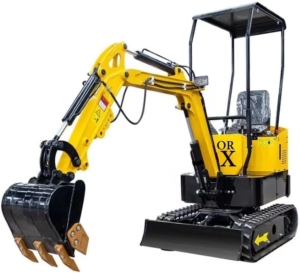How Far Should Excavated Soil and Rocks Be Stored from the Edge of an Excavation?
 When conducting excavation work, safety is paramount for both workers and the surrounding environment. One crucial aspect of maintaining safety during excavation projects is properly managing the storage of excavated soil and rocks. Improper storage of these materials can lead to accidents, structural instability, and environmental issues. This article explores the necessary distance at which excavated soil and rocks must be stored from the edge of an excavation, considering both safety regulations and best practices.
When conducting excavation work, safety is paramount for both workers and the surrounding environment. One crucial aspect of maintaining safety during excavation projects is properly managing the storage of excavated soil and rocks. Improper storage of these materials can lead to accidents, structural instability, and environmental issues. This article explores the necessary distance at which excavated soil and rocks must be stored from the edge of an excavation, considering both safety regulations and best practices.
The Importance of Safe Storage Practices
Excavations create deep voids in the ground, and the edges of these voids, known as the “excavation face,” can be unstable. Without proper management, excavated materials such as soil, rocks, and debris can pose significant risks. If materials are placed too close to the edge, they can cause the excavation to collapse or shift. The weight of these materials may exert pressure on the excavation walls, triggering landslides, slumps, or the formation of dangerous trenches.
Moreover, the proximity of the stockpiled material to the excavation can result in hazardous working conditions for construction workers, including falls, rockslides, and equipment hazards. To mitigate these risks, standards and guidelines for material storage have been developed.
Guidelines for Material Storage
The primary concern when determining how far excavated soil and rocks should be stored from an excavation is the potential for destabilizing the excavation’s walls. Regulatory authorities such as the Occupational Safety and Health Administration (OSHA) in the United States, as well as other international standards, provide guidelines to ensure safe storage distances.
1. OSHA Regulations
According to OSHA, excavated soil and rock should not be stored closer than 2 feet (0.6 meters) from the edge of the excavation. This is a general guideline to prevent the excavation’s walls from becoming overloaded, which could lead to a collapse. However, in certain circumstances (such as during trenching or deep excavations), this distance may need to be increased to ensure stability.
OSHA also advises that stockpiles of excavated material be placed on stable ground, away from areas where vibrations from heavy equipment or other activities might cause destabilization. Additionally, it is essential to avoid placing soil on a slope that could promote material sliding back into the excavation.
2. International Standards
Globally, other safety guidelines provide similar recommendations. For example, the Health and Safety Executive (HSE) in the UK also mandates that excavated material should be stored at a safe distance from the edge of an excavation, although the exact distance may depend on site conditions. In some cases, this distance might need to be extended to prevent soil movement caused by wind, rain, or seismic activity.
3. Factors That Influence Storage Distance
The exact distance that excavated materials should be stored from the edge of an excavation may vary depending on several factors:
- Depth and Size of the Excavation: The deeper and wider the excavation, the greater the risk of instability. In such cases, increasing the storage distance beyond the minimum requirement may be necessary.
- Soil Type: Different soil types have varying degrees of cohesion. Loose, sandy soils or wet materials may require additional precautions, including further distance from the edge, compared to denser or clay-based soils.
- Slope of the Excavation: If the excavation has sloped walls, additional measures should be taken to ensure that stored materials do not roll or slide into the excavation.
- Weather Conditions: Rain, snow, or high winds can affect the stability of stockpiled materials. During wet weather, extra caution should be exercised to ensure that water runoff does not destabilize stockpiles near the excavation edge.
4. Additional Safety Measures
In addition to adhering to distance guidelines, there are other safety practices that should be followed when managing excavated material:
- Shoring or Slope Stabilization: For deeper excavations, shoring systems or benching techniques can help stabilize excavation walls and provide a buffer between the stored material and the edge.
- Regular Inspections: Excavation sites should be regularly inspected by qualified personnel to ensure that material stockpiles remain stable and safe throughout the duration of the project.
- Warning Signs and Barricades: Clear signage and physical barriers should be placed around the excavation site to prevent workers from getting too close to potentially hazardous areas.
Conclusion
The safe storage of excavated soil and rocks is crucial to maintaining a stable excavation environment. OSHA and international safety guidelines recommend storing materials at least 2 feet (0.6 meters) away from the excavation edge, although this distance may need to be increased based on site-specific factors. By understanding and applying the correct safety practices, such as considering soil type, excavation depth, and weather conditions, excavation sites can be kept safe for workers and the surrounding environment. Ultimately, careful planning and adherence to safety guidelines will help prevent accidents, ensuring the integrity of the excavation site throughout the project.


 Our Construction company is Servicing Southeast Michigan, Detroit and the Tri-County area Wyane, Oakland and Macomb;
Our Construction company is Servicing Southeast Michigan, Detroit and the Tri-County area Wyane, Oakland and Macomb;

